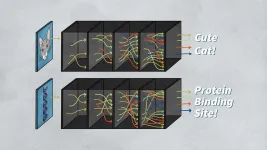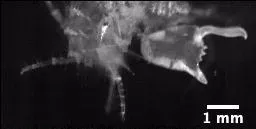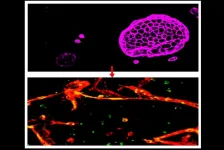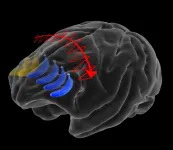AI researchers ask: What's going on inside the black box?
2021-02-08
(Press-News.org) Cold Spring Harbor Laboratory (CSHL) Assistant Professor Peter Koo and collaborator Matt Ploenzke reported a way to train machines to predict the function of DNA sequences. They used "neural nets", a type of artificial intelligence (AI) typically used to classify images. Teaching the neural net to predict the function of short stretches of DNA allowed it to work up to deciphering larger patterns. The researchers hope to analyze more complex DNA sequences that regulate gene activity critical to development and disease.
Machine-learning researchers can train a brain-like "neural net" computer to recognize objects, such as cats or airplanes, by showing it many images of each. Testing the success of training requires showing the machine a new picture of a cat or an airplane and seeing if it classifies it correctly. But, when researchers apply this technology to analyzing DNA patterns, they have a problem. Humans can't recognize the patterns, so they may not be able to tell if the computer identifies the right thing. Neural nets learn and make decisions independently of their human programmers. Researchers refer to this hidden process as a "black box". It is hard to trust the machine's outputs if we don't know what is happening in the box.
Koo and his team fed DNA (genomic) sequences into a specific kind of neural network called a convolutional neural network (CNN), which resembles how animal brains process images. Koo says:
"It can be quite easy to interpret these neural networks because they'll just point to, let's say, whiskers of a cat. And so that's why it's a cat versus an airplane. In genomics, it's not so straightforward because genomic sequences aren't in a form where humans really understand any of the patterns that these neural networks point to."
Koo's research, reported in the journal Nature Machine Intelligence, introduced a new method to teach important DNA patterns to one layer of his CNN. This allowed his neural network to build on the data to identify more complex patterns. Koo's discovery makes it possible to peek inside the black box and identify some key features that lead to the computer's decision-making process.
But Koo has a larger purpose in mind for the field of artificial intelligence. There are two ways to improve a neural net: interpretability and robustness. Interpretability refers to the ability of humans to decipher why machines give a certain prediction. The ability to produce an answer even with mistakes in the data is called robustness. Usually, researchers focus on one or the other. Koo says:
"What my research is trying to do is bridge these two together because I don't think they're separate entities. I think that we get better interpretability if our models are more robust."
Koo hopes that if a machine can find robust and interpretable DNA patterns related to gene regulation, it will help geneticists understand how mutations affect cancer and other diseases.
INFORMATION:
[Attachments] See images for this press release:

ELSE PRESS RELEASES FROM THIS DATE:
2021-02-08
COLUMBUS, Ohio - We know that what happens in the mouth doesn't stay in the mouth - but the oral cavity's connection to the rest of the body goes way beyond chewing, swallowing and digestion.
The healthy human oral microbiome consists of not just clean teeth and firm gums, but also energy-efficient bacteria living in an environment rich in blood vessels that enables the organisms' constant communication with immune-system cells and proteins.
A growing body of evidence has shown that this system that seems so separate from the rest of our bodies is actually highly influential on, and influenced by, our overall health, said Purnima Kumar, professor of periodontology at The Ohio State University, speaking at a science conference this week.
For example, type 2 diabetes has long ...
2021-02-08
New research finds caffeine consumed during pregnancy can change important brain pathways that could lead to behavioral problems later in life. Researchers in the Del Monte Institute for Neuroscience at the University of Rochester Medical Center (URMC) analyzed thousands of brain scans of nine and ten-year-olds, and revealed changes in the brain structure in children who were exposed to caffeine in utero.
"These are sort of small effects and it's not causing horrendous psychiatric conditions, but it is causing minimal but noticeable behavioral issues that should make us consider long term effects ...
2021-02-08
One of humanity's biggest challenges right now is reducing our emissions of greenhouse gases into the atmosphere. Research groups worldwide are trying to find ways to efficiently separate carbon dioxide (CO2) from the mixture of gases emitted from industrial plants and power stations. Among the many strategies for accomplishing this, membrane separation is an attractive, inexpensive option; it involves using polymer membranes that selectively filter CO2 from a mix of gases.
Recent studies have focused on adding low amounts of metal-organic frameworks (MOFs) into polymer matrices to enhance their properties. MOFs are compounds made of a metallic center bonded to organic molecules in a very orderly fashion, producing porous crystals. When added to polymer ...
2021-02-08
DURHAM, N.C. -- The world's most technologically advanced robots would lose in a competition with a tiny crustacean.
Just the size of a sunflower seed, the amphipod Dulichiella cf. appendiculata has been found by Duke researchers to snap its giant claw shut 10,000 times faster than the blink of a human eye.
The claw, which only occurs on one side in males, is impressive, reaching 30% of an adult's body mass. Its ultrafast closing makes an audible snap, creating water jets and sometimes producing small bubbles due to rapid changes in water pressure, a phenomenon known ...
2021-02-08
Bark beetle outbreaks and wildfire alone are not a death sentence for Colorado's beloved forests--but when combined, their toll may become more permanent, shows new research from the University of Colorado Boulder.
It finds that when wildfire follows a severe spruce beetle outbreak in the Rocky Mountains, Engelmann spruce trees are unable to recover and grow back, while aspen tree roots survive underground. The study, published last month in Ecosphere, is one of the first to document the effects of bark beetle kill on high elevation forests' recovery from wildfire.
"The fact that Aspen is regenerating prolifically after wildfire is not a surprise," said Robert Andrus, who conducted ...
2021-02-08
A team of engineers and scientists has developed a method of 'multiplying' organoids: miniature collections of cells that mimic the behaviour of various organs and are promising tools for the study of human biology and disease.
The researchers, from the University of Cambridge, used their method to culture and grow a 'mini-airway', the first time that a tube-shaped organoid has been developed without the need for any external support.
Using a mould made of a specialised polymer, the researchers were able to guide the size and shape of the mini-airway, grown from adult mouse stem cells, and then remove it from the mould when it reached ...
2021-02-08
DANVILLE, Pa. - Researchers at Geisinger have found that a computer algorithm developed using echocardiogram videos of the heart can predict mortality within a year.
The algorithm--an example of what is known as machine learning, or artificial intelligence (AI)--outperformed other clinically used predictors, including pooled cohort equations and the Seattle Heart Failure score. The results of the study were published in Nature Biomedical Engineering.
"We were excited to find that machine learning can leverage unstructured datasets such as medical images and videos to improve on a wide range of clinical prediction models," said Chris Haggerty, Ph.D., co-senior author and assistant ...
2021-02-08
A type of cell derived from human stem cells that has been widely used for brain research and drug development may have been leading researchers astray for years, according to a study from scientists at Weill Cornell Medicine and Columbia University Irving Medical Center.
The cell, known as an induced Brain Microvascular Endothelial Cell (iBMEC), was first described by other researchers in 2012, and has been used to model the special lining of capillaries in the brain that is called the "blood-brain barrier." Many brain diseases, including brain cancers as well as degenerative ...
2021-02-08
Older adults who are classified as having "prediabetes" due to moderately elevated measures of blood sugar usually don't go on to develop full-blown diabetes, according to a study led by researchers at Johns Hopkins Bloomberg School of Public Health.
Doctors still consider prediabetes a useful indicator of future diabetes risk in young and middle-aged adults. However, the study, which followed nearly 3,500 older adults, of median age 76, for about six and a half years, suggests that prediabetes is not a useful marker of diabetes risk in people of more advanced age.
The results were published February 8 in JAMA ...
2021-02-08
Ask anyone from an NFL quarterback scanning the field for open receivers, to an air traffic controller monitoring the positions of planes, to a mom watching her kids run around at the park: We depend on our brain to hold what we see in mind, even as we shift our gaze around and even temporarily look away. This capability of "visual working memory" feels effortless, but a new MIT study shows that the brain works hard to keep up. Whenever a key object shifts across our field of view--either because it moved or our eyes did--the brain immediately transfers a memory of it by re-encoding it among neurons in the opposite brain hemisphere.
The finding, published in Neuron by neuroscientists at The Picower Institute for Learning and Memory, explains via experiments in animals how we can keep ...
LAST 30 PRESS RELEASES:
[Press-News.org] AI researchers ask: What's going on inside the black box?






